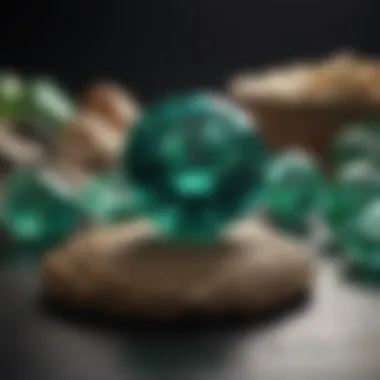Unlocking the Enigmatic World of Natural Emeralds: Exploring the Intriguing Costs


Rock and Fossil Identification
At the core of understanding the world of natural emeralds lies the ability to identify the rocks and fossils that house these precious gemstones. Various types of host rocks can influence the formation and quality of emeralds. Look for specific characteristics such as color, texture, and inclusion patterns within the rocks to determine the potential presence of emeralds. Utilizing tools like magnifiers and UV lights can aid in the identification process, allowing collectors to carefully examine and differentiate emerald-bearing rocks from others.
Geological Insights
Delving deeper into the geological aspects of natural emeralds unveils a fascinating story of their formation. These gemstones typically originate from hydrothermal processes within the Earth's crust, where conditions of high pressure and temperature interact with specific minerals to create the ideal environment for emerald growth. Understanding the geological formations and processes involved provides collectors with valuable insights into the rarity and uniqueness of each emerald specimen. Furthermore, exploring the historical significance of emeralds throughout civilizations highlights their enduring allure and cultural importance over the ages.
Introduction
The Introduction section sets the stage for delving into the mesmerizing world of natural emeralds and uncovering the intricate factors that impact their costs. It serves as a gateway for readers to gain insight into the essence of natural emeralds and why understanding their pricing dynamics is crucial. This segment aims to pique the curiosity of enthusiasts and collectors, guiding them through a journey of exploration and discovery. By highlighting the significance of natural emeralds and their economic value, readers will be prepared to absorb the wealth of information that lies ahead in this enlightening article.
Exploring the Allure of Natural Emeralds
The allure of natural emeralds lies in their mesmerizing beauty and rarity. These gemstones captivate with their rich green hues and distinct luster, making them highly sought after in the world of fine jewelry and gemstone collection. Natural emeralds have a unique charm that transcends time, drawing individuals towards their elegance and sophistication. Exploring the allure of natural emeralds opens a gateway to appreciating their exceptional qualities and the artistry of nature that goes into their formation.
Significance of Understanding Natural Emerald Costs
Understanding the costs associated with natural emeralds is essential for enthusiasts and collectors alike. It goes beyond mere monetary value, shedding light on the intricate factors that contribute to the pricing of these precious gemstones. By comprehending the nuances of natural emerald costs, individuals can make informed decisions when purchasing or investing in these treasures. Delving into the significance of understanding natural emerald costs unveils a deeper appreciation for the intricacies involved in valuing these exquisite gemstones.
Formation of Natural Emeralds
In the realm of natural emeralds, the formation process holds significant importance as it dictates the unique characteristics and value of these exquisite gemstones. Understanding how natural emeralds are formed is crucial for enthusiasts and collectors to appreciate the complexities involved in their creation and to distinguish genuine stones from imitations.
The formation of natural emeralds is a captivating journey that begins deep within the Earth's crust, where a combination of geological processes over millions of years gives rise to these mesmerizing green gems. This section delves into the intricate development of natural emeralds, shedding light on the origins of their mesmerizing beauty and allure.
Geological Processes Behind Emerald Formation
Impact of Chromium and Vanadium
The presence of chromium and vanadium plays a pivotal role in the formation of natural emeralds, infusing them with their distinct green hue and exceptional clarity. Chromium, in particular, is responsible for imparting the vivid green color that is highly sought after in top-quality emeralds. Vanadium works in tandem with chromium to enhance the gem's color saturation and brilliance, making emeralds with higher concentrations of these elements more valuable.


The unique combination of chromium and vanadium not only influences the color intensity of natural emeralds but also contributes to their overall beauty and rarity. These elements interact with other minerals and compounds during the crystallization process, resulting in the formation of gem-quality emeralds with unmatched visual appeal.
Influence of Pressure and Temperature
Pressure and temperature are crucial factors that shape the formation of natural emeralds, exerting immense influence on their quality and characteristics. The ideal geological conditions required for the creation of emeralds involve high pressures and moderate temperatures within the Earth's crust, typically occurring in areas where tectonic plates collide or volcanic activity occurs.
The intense pressure forces the elements necessary for emerald formation to interact and crystallize, while the appropriate temperature range allows for the gradual development of the gemstones over time. This balance of pressure and temperature results in the formation of emeralds with exceptional clarity, color vibrancy, and structural integrity.
By exploring the dynamic interplay between chromium, vanadium, pressure, and temperature in the formation of natural emeralds, our understanding of these gemstones' allure and value is enriched, paving the way for a deeper appreciation of their geological significance.
Factors Influencing Natural Emerald Costs
Exploring the significance of the factors influencing natural emerald costs within the context of this article is crucial for understanding the complex dynamics of pricing in the gemstone market. The pricing of natural emeralds is a multifaceted process influenced by various elements that interact to determine their overall value and desirability.
Color Intensity and Hue Clarity
Color intensity and hue clarity are fundamental factors that greatly impact the cost of natural emeralds. These gemstones derive their allure from their vivid green coloration, with a deep, vibrant hue being highly sought after. The richness and saturation of the green hue significantly contribute to the value of an emerald. Additionally, the presence of secondary colors within the stone can either enhance or detract from its desirability and monetary worth.
Clarity and Transparency Levels
The clarity and transparency levels of a natural emerald play a pivotal role in its pricing. Inclusions, which are internal characteristics within the gemstone, can affect its transparency and overall visual appeal. Emeralds with higher clarity levels, indicating fewer inclusions, are considered more valuable due to their rarity and aesthetic appeal. Gemstones with excellent transparency exhibit a vibrant glow when light passes through them, enhancing their allure and contributing to their higher cost.
Carat Weight and Size Considerations
Carat weight and the physical size of a natural emerald are important considerations when determining its value. Generally, larger emeralds command higher prices compared to smaller ones, assuming color, clarity, and other factors remain consistent. The rarity of larger, high-quality emeralds contributes to their elevated cost, making them a prized possession for collectors and enthusiasts.
Origin and Rarity Factors
The origin of a natural emerald, along with its rarity within the market, significantly influences its price. Emeralds sourced from renowned mining locations are often highly coveted due to their superior quality and historical significance. Additionally, emeralds from rare deposits or with unique characteristics fetch premium prices in the gemstone market. Understanding the origins and rarity factors of natural emeralds is essential in gauging their value and investment potential.
Grading Criteria for Natural Emeralds
In the realm of natural emeralds, understanding the grading criteria is paramount as it serves as the compass for evaluating the quality and value of these exquisite gemstones. The grading criteria act as a standardized framework that allows gemologists and enthusiasts to assess emeralds based on specific parameters, ensuring transparency and consistency in the assessment process.


When delving into the grading criteria for natural emeralds, various elements come into play. Firstly, color intensity and hue clarity play a vital role in determining the value of an emerald. The richness of color and the presence of any undertones significantly impact the overall appeal and price of the gemstone. Secondly, clarity and transparency levels are crucial factors as they indicate the presence of inclusions or imperfections within the emerald, affecting its brilliance and overall beauty.
Moreover, carat weight and size considerations are essential aspects of the grading criteria. Generally, larger emeralds with a higher carat weight command a higher price due to their rarity and visual impact. Finally, the origin and rarity of the emerald also hold significant weight in the grading process. Emeralds sourced from renowned locations known for producing high-quality gems are prized for their exclusivity and unique characteristics.
By adhering to the established grading criteria, buyers and collectors can make informed decisions when evaluating and purchasing natural emeralds. These guidelines help in differentiating between various quality levels and enable individuals to fully appreciate the distinctiveness of each gemstone.
GIA's Emerald Grading Standards
The Gemological Institute of America (GIA) plays a pivotal role in setting industry standards for grading natural emeralds. The GIA's Emerald Grading Standards are highly regarded and widely accepted within the gemstone community for their meticulous approach to evaluating emerald quality.
GIA's grading standards encompass a comprehensive assessment of the 4Cs: Color, Clarity, Cut, and Carat. Each C carries its own significance in determining the overall quality and value of an emerald. The color grading examines the hue, tone, and saturation of the emerald, ensuring a consistent and precise classification system.
Furthermore, clarity evaluation focuses on identifying any inclusions or imperfections within the gemstone, establishing clarity grades that reflect the stone's internal purity. The cut of an emerald influences its brilliance and overall aesthetic appeal, with GIA's standards outlining precise parameters for evaluating cut quality.
Lastly, carat weight measurement is crucial in determining the size and rarity of an emerald, with higher carat weights typically correlating with increased value. By understanding GIA's Emerald Grading Standards and the importance of the 4Cs, buyers and collectors can navigate the emerald market with confidence and discernment, ensuring they acquire gemstones of exceptional quality and beauty.
Market Trends and Price Fluctuations
In the enthralling exploration of natural emeralds, understanding market trends and price fluctuations holds paramount importance. Reflecting the ever-evolving nature of the gemstone market, these trends offer insightful glimpses into the dynamics shaping natural emerald costs. By delving into market trends, enthusiasts and collectors can navigate purchasing decisions with acumen and foresight, ensuring they stay abreast of the latest developments. Observing price fluctuations becomes a strategic tool for gemstone aficionados, aiding in identifying opportune moments for acquisitions or sales.
Emerald Prices Over Time
Tracing the trajectory of emerald prices over time unveils a fascinating narrative of fluctuating values and enduring allure. Throughout history, the pricing of natural emeralds has witnessed fluctuations influenced by various factors, including market demand, availability of high-quality specimens, and global economic conditions. By examining these historical price trends, enthusiasts can gain a profound appreciation for the gemstone's evolving value, recognizing its timeless appeal amidst changing market landscapes.
Factors Driving Price Variations
Exploring the intricate web of factors that drive price variations in the natural emerald market unveils a tapestry of influences shaping gemstone valuations. From geological factors impacting color intensity to market forces dictating rarity premiums, these elements intricately interplay to determine the fluctuating prices of natural emeralds. Understanding these drivers equips collectors and investors with valuable insights into the nuanced dynamics governing pricing structures, enabling them to make informed decisions based on a holistic comprehension of the gemstone market.
Tips for Buying Natural Emeralds
In this detailed exploration of the world of natural emeralds and their costs, the significance of understanding the nuances of purchasing these precious gemstones cannot be understated. When it comes to buying natural emeralds, there are several key elements to consider to ensure a worthwhile investment in these stunning gems.


One crucial aspect for potential buyers is seeking certified gemstones. Certification provides a level of assurance regarding the authenticity and quality of the emerald. By opting for certified gemstones, buyers can have peace of mind knowing that they are acquiring a genuine and valuable piece. Furthermore, certification can also offer insights into the specific characteristics of the emerald, such as its color, clarity, cut, and carat weight, helping buyers make informed decisions.
Another essential factor when buying natural emeralds is considering the origin and sourcing of the gemstone. Emeralds from certain origins may command higher prices due to their rarity or unique characteristics. Understanding the provenance of an emerald can add to its allure and mystique, making it even more desirable to collectors and enthusiasts.
Additionally, buyers should pay attention to the color, clarity, and transparency levels of the emerald. The rich green hue of emeralds is a defining characteristic, with variations in intensity and saturation influencing their value. Clarity and transparency also play a significant role in determining the overall beauty and quality of the emerald, guiding buyers in selecting the perfect gemstone for their collection.
In essence, when it comes to buying natural emeralds, thorough research, attention to detail, and a discerning eye are paramount. By focusing on certified gemstones, understanding origin factors, and evaluating key quality aspects, buyers can embark on a rewarding journey to acquire these mesmerizing gemstones.
Seeking Certified Gemstones
To delve deeper into the realm of purchasing natural emeralds, seeking certified gemstones is a fundamental step in ensuring the authenticity and value of the gemstone. Gemological certifications provided by renowned laboratories offer a comprehensive evaluation of the emerald's quality, including its color, clarity, carat weight, and cut.
By choosing certified gemstones, buyers can gain confidence in the legitimacy of the emerald, safeguarding against purchasing counterfeit or synthetic stones. Certified gemstones also provide vital information on treatments or enhancements that the emerald may have undergone, enabling buyers to make informed decisions based on full disclosure of the gemstone's history.
Moreover, certified gemstones offer a level of transparency that enhances trust between buyers and sellers. With a certified emerald, buyers receive documented proof of the gemstone's characteristics and authenticity, setting a standard for quality and ethical sourcing in the gemstone trade.
In the intricate world of natural emeralds, seeking certified gemstones is a cornerstone practice for those looking to acquire genuine, high-quality gems while ensuring a trustworthy and traceable purchasing process.
Navigating Auctions and Retail Markets
When it comes to buying natural emeralds, navigating auctions and retail markets can offer unique opportunities to acquire exceptional gemstones. Auctions provide a platform for rare and extraordinary emeralds to be (content continues)
Conclusion
In the vast and mysterious world of natural emeralds, the importance of a conclusive understanding cannot be overstated. The conclusion of this article serves as the anchor that ties together the complexity and nuances surrounding the costs of these exquisite gemstones. By revisiting the key points discussed throughout the various sections, readers can gain a holistic perspective on the significant factors influencing natural emerald pricing.
One of the paramount benefits of delving into the conclusion is the ability to synthesize the wealth of information presented, allowing enthusiasts and collectors to make informed decisions when navigating the realm of natural emerald procurement. Understanding the intricate details behind the pricing mechanisms empowers individuals to appreciate the value of these gems beyond their aesthetic appeal.
Moreover, the conclusion acts as a guiding light for those seeking to embark on their journey of acquiring natural emeralds. By highlighting the relevance of comprehensive knowledge in making sound purchasing choices, readers can approach the market with confidence and discernment. Ultimately, the conclusion encapsulates the essence of unraveling the costs associated with natural emeralds, offering a roadmap for navigating this captivating terrain with clarity and insight.
Final Thoughts on Natural Emerald Costs
As we draw to a close on the enthralling exploration of natural emerald costs, it is imperative to reflect on the insights gleaned and their implications for enthusiasts and collectors alike. The final thoughts on natural emerald costs encapsulate a blend of fascination and practicality, providing a nuanced understanding of the factors that contribute to the pricing dynamics of these mesmerizing gemstones.
One of the key takeaways from this journey is the intricate interplay between rarity, quality, and market forces in determining the value of natural emeralds. By delving into the nuances of color intensity, clarity levels, carat weight, and origin considerations, readers can appreciate the multifaceted nature of evaluating these precious gems.
Furthermore, navigating the labyrinth of natural emerald costs unveils a treasure trove of knowledge that goes beyond monetary value. It instills a profound sense of appreciation for the geological processes, extraction methods, and grading criteria that shape the allure and uniqueness of each emerald specimen. Armed with this depth of understanding, individuals can embark on a quest to build a collection that reflects not only beauty but also a deep-seated respect for the marvels of the natural world.
In essence, the final thoughts on natural emerald costs serve as a gateway to a world where beauty meets rarity, where value transcends mere price tags, and where each gemstone tells a story of timeless elegance and natural wonder.







